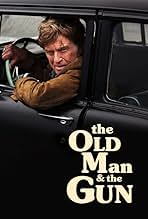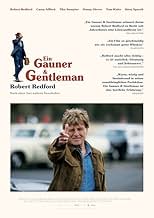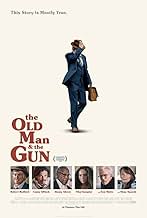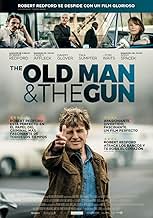Ispirato alla vera storia di Forrest Tucker e alla sua audace fuga da San Quentin all'età di settant'anni a una serie di rapine che hanno confuso le autorità e incantato l'opinione pubblica.Ispirato alla vera storia di Forrest Tucker e alla sua audace fuga da San Quentin all'età di settant'anni a una serie di rapine che hanno confuso le autorità e incantato l'opinione pubblica.Ispirato alla vera storia di Forrest Tucker e alla sua audace fuga da San Quentin all'età di settant'anni a una serie di rapine che hanno confuso le autorità e incantato l'opinione pubblica.
- Premi
- 2 vittorie e 12 candidature totali
- Mechanic
- (as Tomas 'Dutch' Deckaj)
Recensioni in evidenza
Despite the clichéd bank robbery motif, based on the real-life career of serial robber Forrest Tucker, his eighty robberies and 16 prison escapes reveal not a mean man but rather a charmer who robs because it makes him smile and who helps others when he doesn't have to.
Old Man hints at deeper emotional possibilities when it's discovered that his daughter, played by Elizabeth Moss, is unknown to him:
Jewel (Sissy Spacek): "Do you have any children?" Forrest Tucker: "I hope not." The film likes to keep these moments underwritten to suggest the depth as a richness he hasn't ignored but prefers to keep at bay. That spareness of emotion, dialogue, and sustained discourse adds to the mystery of a man who floats above daily intercourse to pursue a passion, albeit robbery.
Redford shuffles a bit like an old man, but he teases us with the wisdom he holds behind that killer smile and a youthful insouciance that makes him ageless.
You will not be revisiting the wisecracking of Butch Cassidy and the Sundance Kid or the sophistication of The Sting; you will get a fun heist film featuring a star who evidences the reason he has 78 entries in his filmography and originated a seminal cultural institution, The Sundance Institute. A bit like the underplaying but still prolific and passionate Forrest Tucker.
It's infectious: "I've been thinking about a bank robbery my whole life." Ryan Gosling
I think a lot it also comes from how little he reveals about his private life. You get the sense that he has nothing to hide, but nothing to present either. He just seems like one of the few honest faces around Hollywood. Because of this, he's always played good guys, rarely stepping into the role of an antagonist. What's good about his role in The Old Man & the Gun is that he plays a criminal whose constantly on that grey line of good and bad.
In 1981, seventy-year-old Forrest Tucker (played by Robert Redford) is a compulsive robber who has a unique way of cleaning out the bank. Unlike the gun wielding, screaming crooks who threaten to kill everyone, Tucker is more likely to walk in with his team, ask for the manager, and simply tell him or her that the bank is being robbed and will use a gun if necessary. The managers comply as he's never rude, and even charming about it. This puts these people in such a relaxed, clearly thrown off position, that he's usually able to walk out without concern.
According to detective John Hunt (played by Casey Affleck), the man assigned to track Tucker, the old man has been in and out of prison several times, always escaping. Hunt spends his time trying to track Tucker throughout Texas, while maintaining his family life. At the same time, Tucker feels confident enough to not only sit with horse rancher Jewel (played by Sissy Spacek), but to also admit he's a bank robber. She too is charmed by his personality and doesn't object. Tucker continues to rob banks, trying to stay ahead of the police and detective Hunt.
As a final outing, The Old Man & the Gun is a good one to go out on. A good but not great movie. It does take advantage of the kind of person Robert Redford is; a charmer. Though I was hesitant, it turns out with the way Redford portrays Tucker, I could see this person as this plausibly good a robbing places. I am glad they also show that he's not a complete success, as they do show that a lot of what he does is more compulsory then anything. This is the kind of role that needs a Robert Redford. This is the kind of role that I could see Cary Grant or Kirk Douglass could have played if the movie had been made back in the eighties.
Speaking of which, director David Lowery (Pete's Dragon, A Ghost Story) tries hard to emulate the style and look of an eighties movies, with a softer picture and even a grainer look. Though I don't know if this makes the movie bad, I'm not sure why this style was done for this kind of movie. I think it was to have a similar feel for the Redford classic, The Sting.
The reason I bring this up is that it results is more of a "style over substance" movie that I think detracts from the movie's more character driven intention. It's still interesting to hear these characters converse, but something about the way it was made kept me unengaged. I think if the project had been made more traditionally, this may have sold it better, showing that Redford isn't a product of the time. The good news is that much of the style is made up with the material and the actors delivering it.
I'll give this seven old hearing pieces out of ten. Though I'm not sure what could have elevated it as one of the greats of his career, Robert Redford does prove that his charisma can carry a movie fine. It'll defiantly please his fans and those wanting a movie that does feel like an eighties movie; not the cult ones, but the slower, more atmospheric ones like a Robert Altman picture. Give it a watch and see if this was a good one to end on.
Telling the "mostly true" story of Forrest Tucker, Lowery's script is based primarily on David Grann's 2003 New Yorker article of the same name. By the time of the article, the 83-year-old Tucker, who had been robbing banks since his early 20s, had amassed at least 80 successful jobs and escaped from prison 18 times. Usually described by the tellers from whom he stole as "gentlemanly" and "charming", his M.O. never changed - he would walk into a bank and ask if he could open an account. When asked what kind, he would pull back his coat, showing his gun (which was often unloaded, and which he never fired), assure the teller that he didn't want any trouble, and quietly talk them through the process of emptying their till. He would then wish them the best, tell them they'd done well, and walk out. The story takes place in 1981, when Tucker was 61 (although in the film, he's 76), and had recently escaped from San Quentin. Meeting a widow named Jewel (Sissy Spacek), after pulling off a job, they strike up a tentative romance. Meanwhile, he is pursued by Det. John Hunt (Casey Affleck), who is starting to respect him more and more.
The first thing you'll notice about Old Man is its pace, which is measured, to say the least. Ostensibly, this is a heist film, but the crime narrative is very much secondary to tone and character beats. Lowery is relatively uninterested in excitement, suspense, plot twists, or any of the usual generic tropes. Instead, approaching the material casually, he focuses on a year of Tucker's life, with a tone as mellow as a film can be; rather than a shot of absinthe, it's a fine Irish malt drunk at a fireplace. Indeed, even within this structure, there's not a huge amount of character development, nor is there much of a dramatic arc. And that's not a criticism. Rather, the meditative, quasi-somnolent pace is very much one of the film's charms. Additionally, Lowery almost completely ignores what, for many, would be the most interesting part of Tucker's story - his 18 escapes. Instead, he puts them all together into one superb montage.
However, for all that, Lowery's primary goal is to create an ode to an icon, and that icon is Robert Redford. Tucker's story is a vehicle which Lowery uses to celebrate Redford; the character is always there, but he exists behind the actor, rather than the other way around. The audience is never allowed to forget that this is Robert Redford on screen, to the point where the performance is self-referential. Indeed, during the escape montage, there's even a clip of Redford from another film, La caccia (1966). There's an obvious correlation between Tucker and Redford of which Lowery wants the audience to be very aware - they are both elderly, and still doing what they do best, reluctant to stop. We can never look past the fact that Tucker is played by Redford, and for the most part, Redford is playing Redford, with the film existing in large part only because it explicitly leans on his back catalogue and real-life legacy. Essentially, the whole thing is an extended metatextual allegory for Redford's own impending retirement, not to mention his reluctance to let go.
As one would expect from Lowery, aesthetically, the film is fascinating. Lowery is very unusual in the sense that, thus far, he has never used the same cinematographer twice. Here, he uses Joe Anderson, whose cinematography is extremely unique, with the celluloid having a gritty, grainy quality, almost as if it were an amateur project. This is because Lowery shot on Super 16, doing so because he wanted it to look like it had been made in the period in which it was set. This is in direct contrast to, say, how Michael Mann shot Nemico pubblico - Public Enemies (2009), with the use of fast, seemingly anachronistic, digital photography creating a sense that what was happening on screen wasn't necessarily taking place in the past, but could easily have been taking place right now. Lowery, in contrast, tries to suture the viewer into the past milieu.
Another important aesthetic point is how much Lowery has obviously been influenced by Michael Mann, to whom there are several homages - a scene in a diner recalls a similarly shot scene between James Caan and Tuesday Weld in Strade violente (1981); the scene in the toilet where Hunt approaches Tucker is an obvious nod to Al Pacino confronting Robert De Niro in Heat - La sfida (1995); and the scene of Tucker gaining inspiration whilst sitting in a cinema recalls a scene where Dillinger (Johnny Depp) does the same thing in Public Enemies.
In terms of problems, there are a few. For many, the film will depend far too much on Redford, specifically the self-referential allusions to his career and legacy. If you're not a fan of his, you will get zero from this, absolutely nothing. Similarly, if you aren't familiar with at least some of his previous work, and his status in Hollywood, the whole thing will probably seem inconsequential. Another problem I have concerns Affleck. I know he's a celebrated actor and so forth, but for me, he plays himself in every single movie. There is virtually nothing to distinguish Hunt from Robert Ford in L'assassinio di Jesse James per mano del codardo Robert Ford (2007) or Les Chandler from Manchester by the Sea (2016), or either of his performances in previous Lowery films. Every performance he gives, he plays a character with the weight of the world on his shoulders, shuffling around, speaking in a low-key hang-dog voice, reluctant to make eye contact, shifting on his feet.
Lowery also has a strange habit of introducing themes which seem to be setting something up, only to completely abandon them without any kind of engagement. This is most obvious in relation to Hunt's inter-racial marriage to Maureen (Tika Sumpter) and their two mixed-race children. This is a fictional element added by Lowery, so one assumes there was some thought behind it. But this is Texas in 1981; there wouldn't have been a huge amount of mixed marriages. Yet Lowery seems to portray it as if it's the most normal thing in the world. Indeed, for the wife and children, life is fairly idyllic, with not a hint of any kind of societal disapproval. Why would you introduce a mixed-race marriage into this milieu without commenting on it?
These issues aside, however, The Old Man & the Gun is a fine film. As much about Robert Redford as it is Forrest Tucker, although that won't appeal to everyone, there is much to praise. Made in a key so low, it's practically subterranean, Lowery hinges everything on Redford's presence, and, for the most part, it works well. There's little in here to get overly excited about, but neither is there much to criticise. Yes, the film is somewhat insubstantial, and there's virtually nothing here beyond the Redford/Tucker character, but it's still beautifully made, and, honestly, there's nothing wrong with spending 93 minutes hanging out with Redford, whether he's playing Forrest Tucker or Robert Redford. Whether or not this is actually his last performance remains to be seen, but if it is, it's as fine a send-off as any Hollywood icon could hope for.
Lo sapevi?
- QuizIn an interview he gave during the 2018 Toronto International Film Festival, Robert Redford talked about this comedic film being a good note to end on, since the actor wanted his "last acting job to be fun."
- BlooperForrest is arrested in 1981 at the age of 74, which puts his birth year at 1907. But a flashback shows him as a tween breaking out of a juvenile center in 1936--when he would have been 29.
- Citazioni
Stephen Beckley Jr., Esquire: I remember I sat down with him once and I said, "Forrest, surely there's an easier way for somebody in your position to make a living." And he looked at me and he said, "Brother, I'm not talking about making a living. I'm just talking about... living."
- Curiosità sui creditiJade Healy is credited as Wallpaper Whisperer!
- ConnessioniEdited from La caccia (1966)
- Colonne sonore30 Century Man
Written by Scott Walker (as Scott Engel)
Performed by Scott Walker
Used by permission of Carbert Music Inc.
Courtesy of Mercury Records Limited
Under license from Universal Music Enterprises
I più visti
Dettagli
- Data di uscita
- Paesi di origine
- Siti ufficiali
- Lingue
- Celebre anche come
- Un caballero y su revólver
- Luoghi delle riprese
- Dayton, Ohio, Stati Uniti(Liberty Tower, 120 W. 2nd St., Dayton, Ohio 45402)
- Aziende produttrici
- Vedi altri crediti dell’azienda su IMDbPro
Botteghino
- Lordo Stati Uniti e Canada
- 11.277.120 USD
- Fine settimana di apertura Stati Uniti e Canada
- 142.131 USD
- 30 set 2018
- Lordo in tutto il mondo
- 17.860.397 USD
- Tempo di esecuzione1 ora 33 minuti
- Colore
- Proporzioni
- 2.35 : 1
Contribuisci a questa pagina









































